1. Introduction
 Apacer Technology Inc. manufactured its first RAM module back in 1998. After 7 years in the market place, Apacer has expanded its product line to include MP3 Players, embedded flash solutions, USB Flash drives and multimedia storage solutions. Apacer recently released a series of RAM modules that promise high speed performance for both DDR and DDR2 configurations.
Apacer Technology Inc. manufactured its first RAM module back in 1998. After 7 years in the market place, Apacer has expanded its product line to include MP3 Players, embedded flash solutions, USB Flash drives and multimedia storage solutions. Apacer recently released a series of RAM modules that promise high speed performance for both DDR and DDR2 configurations.
In this review, we will be testing the Real500 PC4000 DDR-RAM modules where Apacer's engineers have managed to reach 500MHz frequency in a DDR module. We received 2 DDR modules, tested by Apacer to work in Dual Channel mode (2x512MB).
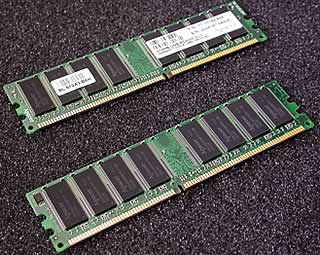

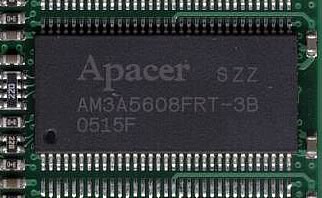
Apacer developed their own chipset for these memory modules, the Apacer AM3A5608FRT-3B. However, it should be clarified that there are two kinds of Apacer PC4000 memory modules on the market. Below you can see the other PC4000 model, offering CL3 and can be easily discerned by the gold heat spreader. These modules (as with the one in the picture below) do not use the Apacer chipset but instead, the well known Samsung TCCD. There is a wide range of manufacturers, like OCZ and Corsair, who also use the Samsung chipsets.

The Apacer chipset offers 500MHz maximum running frequency, at 2.5V (~2.9V maximum voltage, CL3).
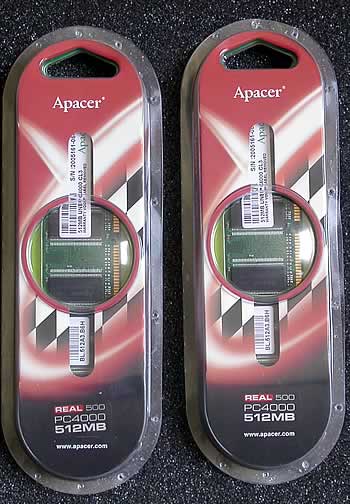
- Specifications
Below you can see the table with all the specifications for the Apacer Real500 RAM modules.
| Product Name |
Real500 PC4000 |
Part Number
|
77.10749.644 |
| Package |
1024MB kit (2x512MB) (dual rank) |
CAS Latency
|
3-4-4-10 |
| Test Voltage |
2.5 V |
| Speed |
DDR 500 MHz (PC4000) |
| Type |
184-pin DDR SDRAM |
| Error Checking |
Non-ECC |
| Registered/Unbuffered |
Unbuffered |
| Manufacturer Warranty |
lifetime conditional warranty |
2. Test Configuration & System
After installing the two memory modules, we checked from the BIOS utility and then with CPU-Z to see the SPD Timings. As you can see, 3-4-4-10 running at 250MHz (dual channel) is the SPD setting.
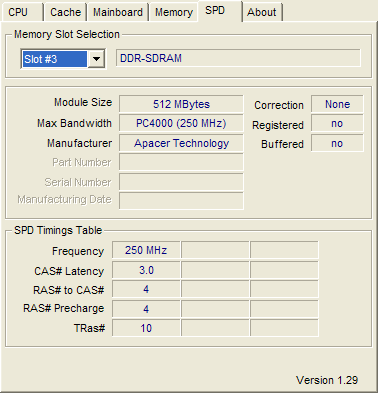
However, when setting the DDR configurations to AUTO, the BIOS will not let the memory run higher than 200MHz (3-3-3-8, dual channel).
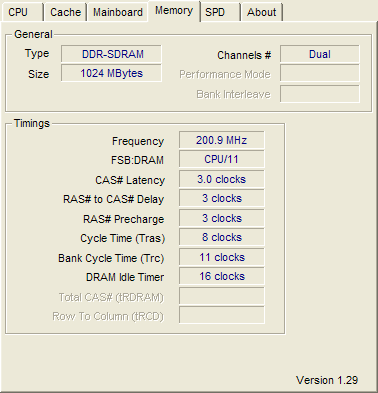
For these tests, we used an AMD Athlon 64 3500+ CPU (Newcastle), running at 2200MHz.
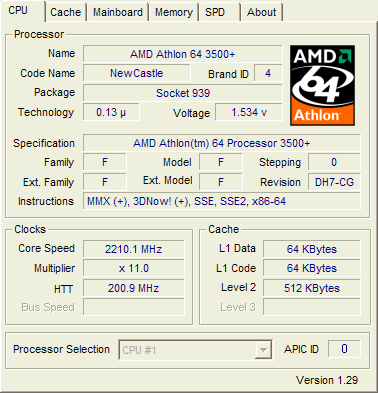
In this review, we will be comparing the Apacer Real500 Ram Modules with the Corsair XMS TwinX 1024-3200XL. Below you can see the SPD Timings for the Corsair XMS memory modules, according to CPU-Z.

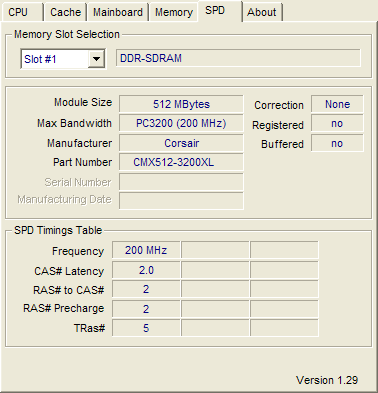
Here's a rundown of our testbed:
System Specifications
CPU: AMD Athlon 64 3500+ CPU (Newcastle)
Case: Antec
Motherboard: Abit AN8 Fatal1ty
Power supply: CoolerMaster 450W
Memory: Apacer Real500 PC4000 (2x512MB)
VGA: ASUS 6800GT PCI-E
Hard Disk Drive: WD800JD 80GB 7200RPM
OS: Windows XP Pro SP2
Drivers: 7.1.8.4
DirectX: v9.0c
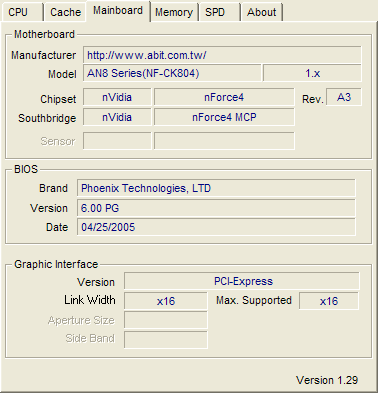
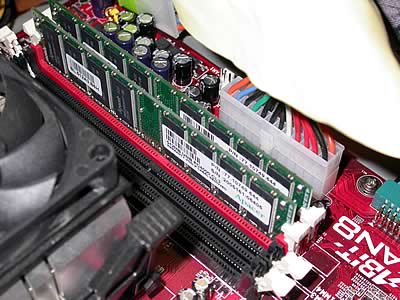
Benchmarks & Applications used
- Memtest86+-1.60
- Sisoft Sandra 2005
- PcMark05
- Performance Test V5.0 ( PassMark)
- Half Life 2 - VST
- CPU-Z v1.29
3. SiSoft Sandra 2005
 SiSoftware Sandra is a 32 and 64-bit Windows system analyser that includes benchmarking, testing and listing modules. It tries to go beyond other utilities to show you more of what is really going on under the hood so you draw comparisons at both a high and low-level in a single product.
SiSoftware Sandra is a 32 and 64-bit Windows system analyser that includes benchmarking, testing and listing modules. It tries to go beyond other utilities to show you more of what is really going on under the hood so you draw comparisons at both a high and low-level in a single product.
You can get information about the CPU, chipset, video adapter, ports, printers, sound card, memory, network, Windows internals, AGP, ODBC Connections, USB2, Firewire etc.
You can save/print/fax/e-mail/post/upload or insert into ADO/ODBC databases reports in text, HTML, XML, SMS/DMI or RPT format.
This version supports multiple sources of information gathering including: remote computers, PDAs, Smart Phones, ADO/ODBC databases or saved system reports.
All benchmarks are optimised for both SMP & SMT (Hyper-Threading), up to 32/64 CPUs depending on the platform.
Memory Bandwidth Benchmark
Tests how your memory sub-system compares to other systems with the same or similar memory in other systems. The benchmark is based on the well-known STREAM memory bandwidth benchmark.
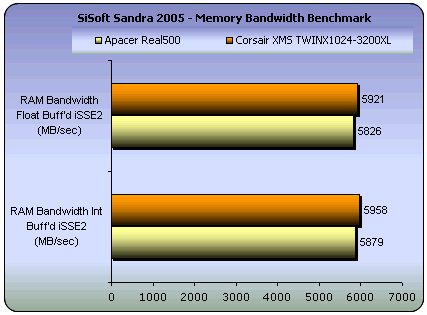
Cache & Memory Benchmark
Tests how your CPU cache and memory sub-system(s) compares to other systems with the same or similar CPU & memory in other systems. The benchmark is based on the Memory Bandwidth Benchmark test.
Combined Index: is a composite figure representing the overall performance rating of the entire Cache-Memory performance in terms of MB/s. The value is the logarithmic average of all the results for the entire address space. (Higher is better, i.e. better performance)
For block sizes that could not been tested - the average of previous blocks is used, thus the size of the memory (as long as it is not comparable to largest cache size) is not significant; all cache sizes are significant - larger caches will result in a higher index.
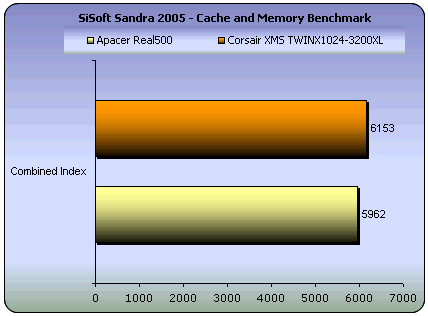
Speed Factor: is a figure representing the speed differential between the CPU’s cache and memory. The value is the ratio of the fastest cache (i.e. L1) bandwidth to the main memory bandwidth. (Lower is better, i.e. the memory is not very much slower than CPU’s cache)
As the factor is a ratio, it is useful only in comparing different CPUs and memory sub-systems rather than having a direct, physical interpretation associated to its numerical value.
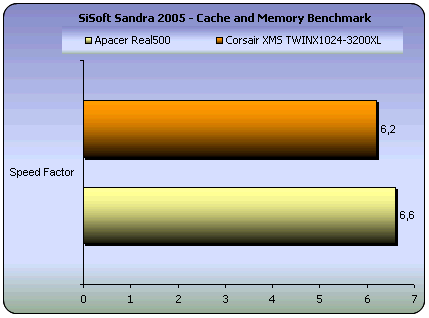
Although Corsair's XMS rated frequency is lower then the Real500's, the XMS modules delivered better performance. The Real500 was close behind though.

4. PCMark05
 PCMark05 is an application-based benchmark and a premium tool for measuring overall PC performance. It uses portions of real applications instead of including very large applications or using specifically created code. This allows PCMark05 to be a smaller installation as well as to report very accurate results. As far as possible, PCMark05 uses public domain applications whose source code can be freely examined by any user.
PCMark05 is an application-based benchmark and a premium tool for measuring overall PC performance. It uses portions of real applications instead of including very large applications or using specifically created code. This allows PCMark05 to be a smaller installation as well as to report very accurate results. As far as possible, PCMark05 uses public domain applications whose source code can be freely examined by any user.
PCMark05 includes 4 categorized suites for benchmarking your computer. These include CPU, Graphics, Memory and a Hard Disk Drive benchmark. In our case, we selected to run only the Memory test suite.
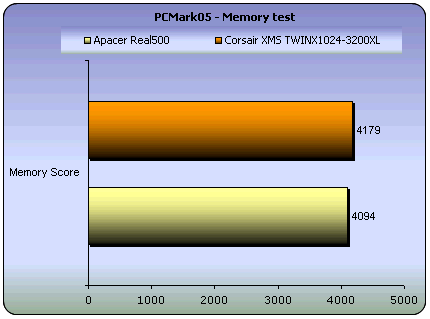
The PCMark memory tests indicate that the Corsair XMS PC3200 memory is faster than the PC4000 memory. This mainly has to do with the timings and not with the running frequency. You can easily set the Apacer Real500 memory to operate at the same timings as the Corsair memory (2-2-2-5). We experimented with the timings at 2-2-2-5 and got similar results to those of the Corsair XMS memory. However, we chose to do ours tests without making any changes of this kind, since most users will operate the memory at its standard settings.
PCMark05
Memory Test |
Apacer Real500 |
Corsair XMS TWINX1024-3200XL |
| Memory Read 16MB |
5918.761 |
6018.050 |
| Memory Read 8MB |
6042.337 |
6146.775 |
| Memory Read 192KB |
10774.117 |
10808.938 |
| Memory Read 4KB |
27970.318 |
28036.627 |
| Memory Write 16MB |
5892.469 |
5920.201 |
| Memory Write 8MB |
5880.213 |
5947.440 |
| Memory Write 192KB |
7002.098 |
7027.576 |
| Memory Write 4KB |
21453.559 |
21515.932 |
| Memory Copy 16MB |
5681.817 |
5745.178 |
| Memory Copy 8MB |
5762.229 |
5777.745 |
| Memory Copy 192KB |
4406.925 |
4420.483 |
| Memory Copy 4KB |
11395.134 |
11464.957 |
| Memory Latency 16MB |
11.216 |
12.462 |
| Memory Latency 8MB |
12.462 |
14.318 |
| Memory Latency 192KB |
134.880 |
134.880 |
| Memory Latency 4KB |
734.751 |
734.751 |
5. Performance Test v.5
 Passmark PerformanceTest is an award winning PC hardware benchmark utility that allows everybody to quickly assess the performance of their computer and compare it to a number of standard 'baseline' computer systems.
Passmark PerformanceTest is an award winning PC hardware benchmark utility that allows everybody to quickly assess the performance of their computer and compare it to a number of standard 'baseline' computer systems.
Twenty seven standard benchmark tests are available in seven test suites plus there are five advanced testing windows for custom benchmarking. CPU Tests, 2D Graphics Tests, 3D Graphics Tests, Disk Tests, Memory Tests and CD/DVD Tests. In our case we selected the Memory suite Tests.
- Memory Benchmarks
This suite contains a number of tests that exercise the memory sub-system of the computer. (Random Access Memory- RAM)
Memory - Allocate small block
This test measures the time taken to allocate & free small zeroed memory blocks (around 100KB block size)
Memory - Cached
This test measures the time taken to read a small block of memory. The block is small enough to be held entirely in cache (if one is present)
Memory - UnCached
This test measures the time taken to read a large block of memory. The block is too large to be held in cache.
Memory - Write
This test measures the time taken to write information into memory.
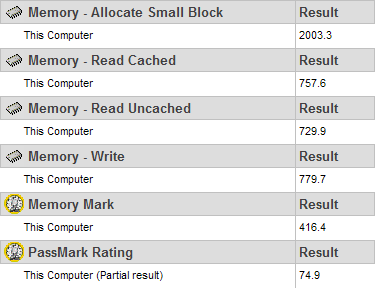
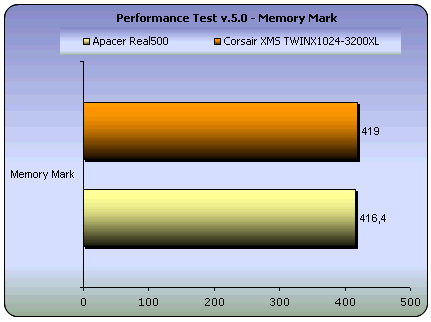
- Advanced Memory Benchmark
Memory Speed Per Access Step Size
The first test type, ‘Memory Speed Per Access Step Size’ accesses a large block, of memory in various sized steps. First, it runs through the block of memory sequentially, accessing every value. Next it runs through the same block again, except this time it accesses every second value. On this occasion, it runs through the block twice in order to access the same amount of data as the initial step. Next it runs through the same block again, except this time it accesses every fourth value and so makes four passes. And so on, until a certain maximum step size is reached.
The size of the block of memory used for this test is one quarter the amount of system RAM. The size of the steps varies from 1 (continuous sequential access), to one quarter the size of the block of memory ( i.e. one sixteenth of the system RAM ).
| Memory Speed (MB/Sec. per Step Size) |
| Apacer Real500 |
| Block Read Speed |
18.93 |
| Block Write Speed |
22.20 |
| Corsair XMS TWINX1024-3200XL |
| Block Read Speed |
20.54 |
| Block Write Speed |
23.81 |
Memory Speed Per Block Size
When a computer program wants to use a section of memory to store data, it makes a request to Windows for the amount of memory it requires. Windows allocates the memory to the program ( unless system resources are very low ) and returns to the requesting program the address of the first memory slot in the allocated block. It is possible that some programs may request very large amounts of memory. The ‘Memory Speed Per Block Size’ test like the ‘Memory Speed Per Access Step Size’ test, is composed of many steps. During each step of the test, PerformanceTest requests a block of memory and runs through the block measuring the average access time. However on each subsequent step the size of the requested memory is increased, until finally a block close to the size of the system RAM is requested. In this way it is possible to observe the different access speeds for the different sizes of blocks.
Typically it is possible to see very fast memory access for blocks which are small enough to fit entirely into the L2 RAM cache, and slower access times for larger blocks accessed from main RAM. In the case where system resources are low, swapping to the disk may even be required for very large blocks.
| Memory Speed (MB/Sec. per Block Size) |
| Apacer Real500 |
| Block Read Speed |
178.83 |
| Block Write Speed |
223.27 |
| Corsair XMS TWINX1024-3200XL |
| Block Read Speed |
179.43 |
| Block Write Speed |
223.90 |
Again we notice the the Corsair memory was slightly faster due to the timings of 2-2-2-5 for the Corsair as opposed to 3-4-4-10 for Apacer.
6. Half Life 2 - Video Stress Test
 Half life 2 is no doubt the most anticipated pc game of all times.
Half life 2 is no doubt the most anticipated pc game of all times.
Physics - From pebbles to water to 2-ton trucks respond as expected, as they obey the laws of mass, friction, gravity, and buoyancy.
Graphics - Source's shader-based renderer, like the one used at Pixar to create movies such as Toy Story® and Monster's, Inc.®, creates the most beautiful and realistic environments ever seen in a video game.
AI - Neither friends nor enemies charge blindly into the fray. They can assess threats, navigate tricky terrain, and fashion weapons from whatever is at hand.

The difference of ~1.7fps in Half Life 2 indicates that both memories performed almost equally in this test with the Corsair memory again slightly faster.
7. Overclocking
The Apacer Real500 modules are intended to operate at 500MHz frequency, but with all the motherboards that we used (ASUS A8N-SLI, Abit AN8 Fatal1ty, etc) we got 400MHz running frequency as standard value. We had to change some BIOS settings to get the 500MHz frequency (2x250MHz, dual channel). We used the Abit motherboard, as before.
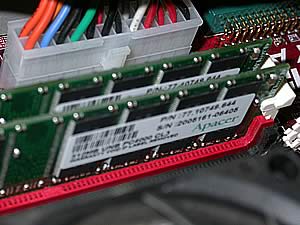
We used 3-3-3-8 timings and ran MemTest to check the stability of the system. After several error messages, we changed to the factory default timings (3-4-4-10) to get the memory running stable at 500MHz.

We re-ran some tests with the memory operating at 500MHz to see if there was any performance boost.





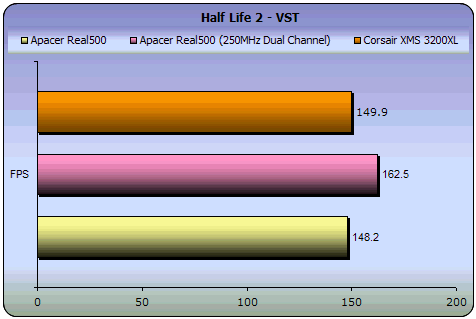
The Apacer Real500 showed their true value when running at 500MHz. Outstanding performance, even faster than the award winning Corsair XMS memory. This is the fastest DDR1 memory module that CDRinfo has tested. The only drawback is that you need to fiddle with the BIOS settings to get that high performance.

8. Conclusion
 Apacer is a well known manufacturer of RAM modules world-wide. These are the first memory modules that can actually run at 500MHz. However, you should be aware that there are some compatibility problems with some motherboards. This in most cases is a matter of a BIOS update, so, every motherboard manufacturer is now working to provide updates that support 500MHz running frequencies. We tested the Apacer Real500 2x512MB and we have mixed thoughts about this memory.
Apacer is a well known manufacturer of RAM modules world-wide. These are the first memory modules that can actually run at 500MHz. However, you should be aware that there are some compatibility problems with some motherboards. This in most cases is a matter of a BIOS update, so, every motherboard manufacturer is now working to provide updates that support 500MHz running frequencies. We tested the Apacer Real500 2x512MB and we have mixed thoughts about this memory.

First of all, the comparison with the Corsair XMS 3200XL memory proved a fitting challenge. The Corsair memory is one of the fastest memories around and it is not easy to compete with the kind of speed performance offered by Corsair. The default speed value we got with the Abit AN8 Fatal1ty was 400MHz (2x200MHz, dual channel), and we decided to stay with this frequency in our standard tests, since most users will not want to fool around with their BIOS settings.
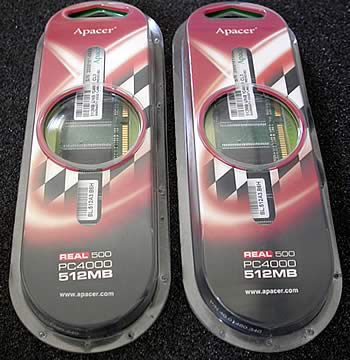
Performance at this speed was satisfactory and in all tests, the Corsair memory was slightly faster than Apacer. However, when we tweaked the Real500s up to 500MHz, Corsair was outgunned. The performance difference between Corsair (400MHz) and Apacer (500MHz) was now evident.
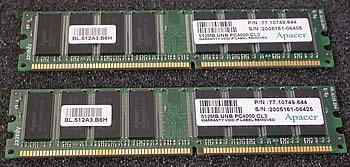
The Apacer Real500 PC4000 are priced at around €60 per module, which is a very good price.
The Good:
- Excellent performance at 500MHz
- Cool operation
- Very good price
The Bad:
- Average performance at 400MHz
- Must interfere with the BIOS settings to get 500MHz operating frequency